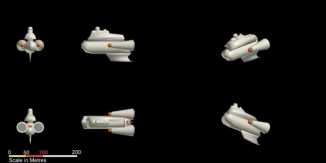“The Stellarford II (Mk4) was an attempt to restart production using new technologies in the shape of the FWH-1 warp drive. However only five new build ships were completed before the shipyard went bust due to the high costs of building the class compared to newer modular vessels, a further hull was abandoned while 60% complete. These five ships were procured by Mars shipping as part of the civilian reserve fleet program, which saw Star Fleet underwrite a proportion of the cost of acquisition of the ships in return for them being made available in times of emergency.
The performance of the Mk4 prompted Star Fleet to offer to underwrite the conversion of Mk3 ships to the standard, again in return for use of the ships in times of war. At the time the conversion of a such a number of large elderly ships was thought to be pointless, but with hindsight it can be seen that it was a perfectly timed program. 20 ships were modified to this mark by 2247, and that was planned to be the end of the program.
Visually, the Mk4 could be easily distinguished from the earlier versions as the short FFTL-3B nacelles were replaced with the much longer dilithium energised FWH-1 nacelles. The more modern construction and materials of the nacelles meant that despite their increased size they massed substantially less, meaning the class reverted to Class IV mass (unladen) and Class VI (Laden).
The increasing hositilities with the Klingon Empire prompted Star Fleet to reassess its needs for assault ships, and in 2251 an incomplete new build Mk4 Stellarford Class liner was taken in hand by Star Fleet Division and completed to Mk5 standards. The Mk5 added fore and aft accelerator cannons in the former bow and stern observation decks, as well as two pairs of lasers covering all arcs fore and aft at the top of the ‘sail’ assembly. These weapons were intended for use in self defence only, as part of the new role of assault ship. Later that year the six newest remaining Mk3s were converted to this standard, as well as four of the new build Mk4s and a pair of rebuilt Mk4s. In total 13 ships commissioned as Mk5s.
| Class: | IV-V | Year: | 2251 | |
| Ship Source: | Spaceflight Chronology | Ship Datasheet: | Download PDF | |



















You must be logged in to post a comment.